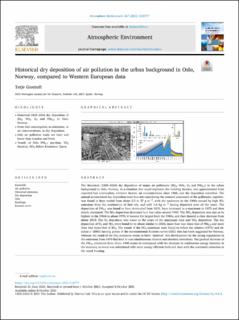Historical dry deposition of air pollution in the urban background in Oslo, Norway, compared to Western European data
Peer reviewed, Journal article
Published version
Permanent lenke
https://hdl.handle.net/11250/2789237Utgivelsesdato
2021Metadata
Vis full innførselSamlinger
- Publikasjoner fra Cristin - NILU [1329]
- Vitenskapelige publikasjoner [1068]
Sammendrag
The historical (1835–2020) dry deposition of major air pollutants (SO2, NOx, O3 and PM2.5) in the urban background in Oslo, Norway, in a situation that could represent the building facades, was approximated from reported fuel combustion, emission factors, air concentrations since 1960, and dry deposition velocities. The annual accumulated dry deposition (and thus not considering the removal processes) of the pollutants, together, was found to have varied from about 2.3 to 27 g m−2, with the maximum in the 1960s caused by high SO2 emissions from the combustion of fuel oils, and with 1.6 kg m−2 having deposited over all the years. The deposition of PM2.5 was found to have dominated from 1835, have increased to a maximum in 1875 and then slowly decreased. The SO2 deposition decreased to a low value around 1990. The NOx deposition was also at its highest in the 1960s to about 1970, it became the largest from the 1980s, and then showed a clear decrease from about 2010. The O3 deposition was lower in the years of the maximum total and NOx deposition. The dry deposition of O3 and NOx were found to be about similar in 2020, more than two times that of PM2.5 and more than four times that of SO2. The trends of the NOx emissions were found to reflect the relative (1975) and absolute (∼2000) turning points of the environmental Kuznets curves (EKC) that has been suggested for Norway, whereas the trend of the SO2 emissions seems to have “shortcut” this development by the strong regulations in the emissions from 1970 that lead to near simultaneous relative and absolute reductions. The gradual decrease of the PM2.5 emissions from about 1945 seems to correspond with the decrease in combustion energy intensity in the economy as wood was substituted with more energy efficient fuels and then with the continued reduction in the wood burning.

